Washington County Durham
HOME WHAT'S WHERE
Memories of Washington Schools
An Usworth Headmaster's Memories
Usworth Teacher/Headmaster's Memories
Mr J. S. Hylton
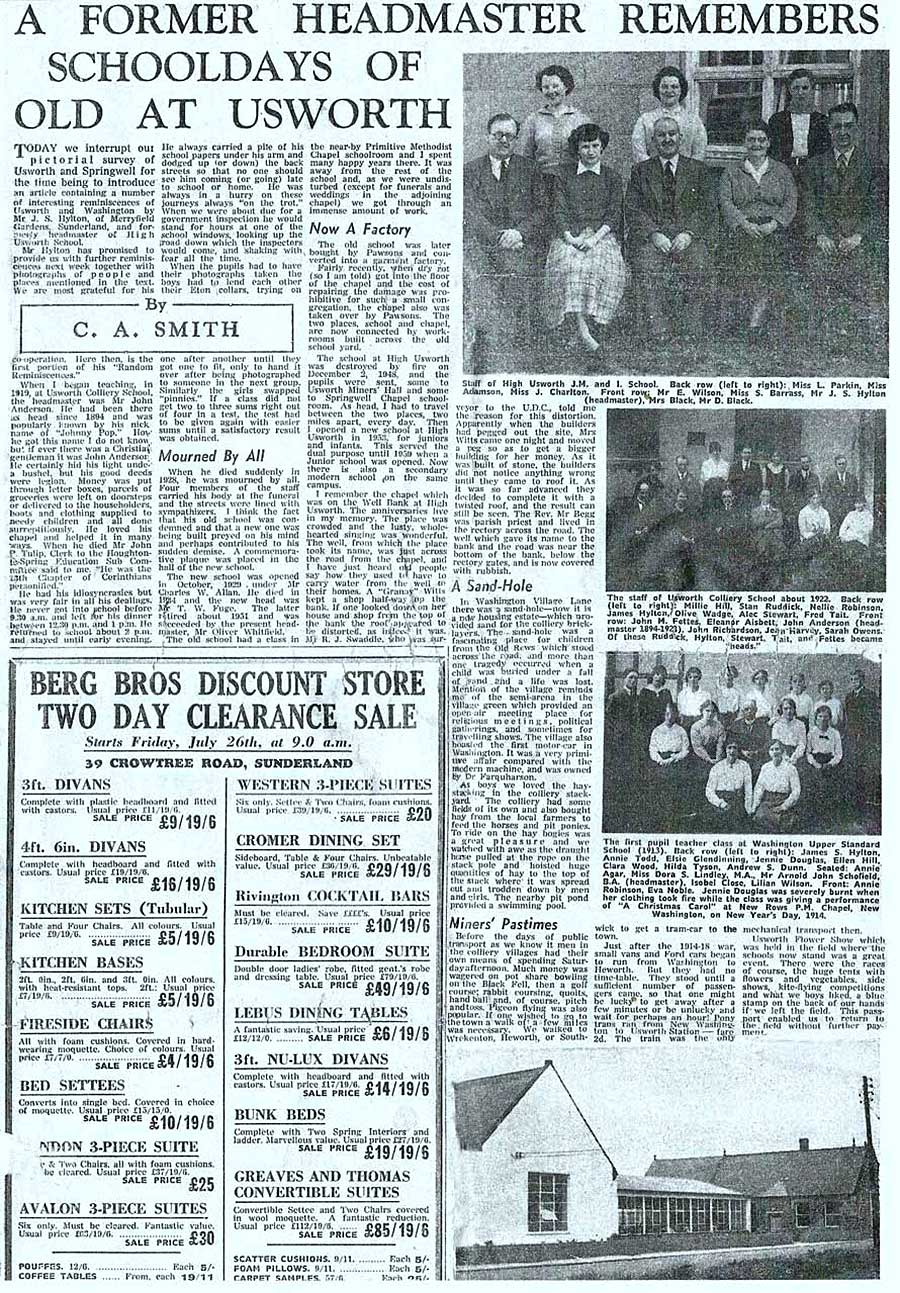
Zoom-in to Read ... or see Typescript Below
Typescript
A FORMER HEADMASTER REMEMBERS SCHOOLDAYS OF OLD AT USWORTH
Today we interrupt our pictorial survey of Usworth and Springwell for the time being to introduce an article containing a number of interesting reminiscences of Usworth and Washington by Mr J. S. Hylton, of Merryfield Gardens, Sunderland, and formerly headmaster of High Usworth School.
Mr Hylton has promised to provide us with further reminiscences next week together with photographs of people and places mentioned in the text. We are most grateful for his co-operation. Here then, is the first portion of his "Random Reminiscences".
When I began teaching, in 1919, at Usworth Colliery School, the headmaster was Mr John Anderson. He had been there as head since 1894 and was popularly known by his nickname "Johnny Pop". How he got this name I do not know, but if ever there was a Christian gentleman it was John Anderson. He certainly hid his light under a bushel, but his good deeds were legion. Money was put through letter boxes, parcels and groceries were left on doorsteps or delivered to the householders, boots and clothing supplied to needy children and all done surreptitiously. He loved his chapel and helped it in many ways. When he died Mr John P. Tulip, Clerk to the Houghton-le-Spring Education Sub Committee said to me, "He was the 13th Chapter of Corinthians personified."
He had his idiosyncrasies but was very fair in all his dealings. He never got into school before 9.30 a.m. and left for his dinner between 12.30 p.m. and 1 p.m. He returned to school about 2 p.m. and stayed until early evening. He always carried a pile of his school papers under his arm and dodged up (or down) the back streets so that no one should see him coming (or going) late to school or home. He was always in a hurry on these journeys always "on the trot". When we were due for a government inspection he would stand for hours at one of the school windows, looking up the road down which the inspectors would come, and shaking with fear all the time.
When the pupils had to have their photographs taken the boys had to lend each other their Eton collars, trying on one after the other until they got one to fit, only to hand it over after being photographed to someone in the next group. Similarly the girls swapped "pinnies". If a class did not get two or three sums right out of four in a test, the test had to be given again with easier sums until a satisfactory result was obtained.
Mourned By All
When he died suddenly in 1928, he was mourned by all. Four members of the staff carried his body at the funeral and the streets were lined with sympathizers. I think the fact that his old school was condemned and that a new one was
being built preyed on his mind and perhaps contributed to his sudden demise. A commemorative plaque was placed in the hall of the new school.
The new school was opened in October, 1929 under Mr Charles W. Allan. He died in 1934 and the new head was Mr T. W. Fuge. The latter retired around 1951 and was succeeded by the present headmaster, Mr Oliver Whitfield. The old school had a class in near-by Primitive Methodist Chapel schoolroom and I spent many happy years there. It was away from the rest of the school and, as we were undisturbed (except for funerals and weddings in the adjoining chapel) we got through an immense amount of work.
Now A Factory
The old school was later bought by Pawsons and converted into a garment factory. Fairly recently, when dry rot (so I'm told) got into the floor of the chapel and the cost of repairing the damage was prohibitive for such a small congregation, the chapel also was taken over by Pawsons. The two places, school and chapel, are now connected
by workrooms built across the old school yard.
The school at High Usworth was destroyed by fire on December 2, 1948, and the pupils were sent, some to Usworth Miners' Hall and some to Springwell Chapel schoolroom. As head, I had to travel between the two places, two miles apart, every day. Then I opened a new school at High Usworth in 1953, for juniors and infants. This served the dual purpose until 1959 when a Junior school was opened. Now there is also a secondary modern school on the same campus.
I remember the chapel which was on the Well Bank at High Usworth. The anniversaries live in my memory. The place was crowded and the lusty, wholehearted singing was wonderful. The well, from which the place took its name, was just across the road from the chapel, and I have just heard old people say how they used to have to carry water from the well to their homes. A "Granny" Witts kept a shop halfway up the bank. If one looked down on her house and shop from the top of the bank the roof appeared to be distorted, as indeed it was. Mr R. J. Swaddle, who was surveyor to the U.D.C., told me the reason for this distortion. Apparently when the builders had pegged out the site, Mrs Witts came one night and moved a peg so as to get a bigger building for her money. As it was built of stone, the builders did not notice anything wrong until they came to roof it. As it was so far advanced they decided to complete it with a twisted roof, and the result can still be seen. The Rev. Mr Begg was parish priest and lived in the rectory across the road. The well which gave its name to the bank and the road was near the bottom of the bank, below the rectory gates, and is now covered with rubbish.
A Sand-Hole
In Washington Village Lane there was a sand-hole - now it is a new housing estate - which provided sand for the colliery bricklayers. The sand-hole was a fascinating place for children from the Old Rows which stood across the road, and more than one tragedy occurred when a child was buried under a fall of sand and a life was lost.
Mention of the village reminds me of the semi-arena in the village green which provided an open-air meeting place for religious meetings, political gatherings, and sometimes for travelling shows. The village also boasted the first motor-car in Washington. It was a very primitive affair compared with the modern machine, and was owned by Dr Farquarson.
As boys we loved the hay-stacking in the colliery stack yard. The colliery had some fields of its own and also bought hay from the local farmers to feed the horses and pit ponies. To ride on the hay bogies was a great pleasure and we watched with awe as the draught horse pulled at the rope on the stack pole and hoisted huge quantities of hay to the top of the stack where it was spread out and trodden down by men and girls. The nearby pit pond provided a swimming pool.
Miners' Pastimes
Before the days of public transport as we know it men in the colliery villages had their own means of spending Saturday afternoon. Much money was wagered on pot share bowling on the Black Fell, then a golf course; rabbit coursing, quoits, hand ball and, of course, pitch and toss. Pigeon flying was also popular. If one wished to go to the town a walk
of a few miles was necessary. We walked to Wrekenton, Heworth or Southwick to get a tram-car to the town.
Just after the 1914-18 war, small vans and Ford cars began to run from Washington to Heworth. But they had no timetable. They stood until a sufficient number of passengers came, so that one might be lucky to get away after a few minutes or unlucky and wait for perhaps an hour! Pony traps ran from New Washington to Usworth Station - fare 2d. The train was the only mechanical transport then.
Usworth Flower Show which was held in the field where the schools now stand was a great event. There were the races of course, the huge tents with flowers and vegtables, side shows, kite flying competitions and what we boys liked, a blue stamp on the back of our hands if we left the field. This passport enabled us to return to the field without further payment.
Images From Press Cutting
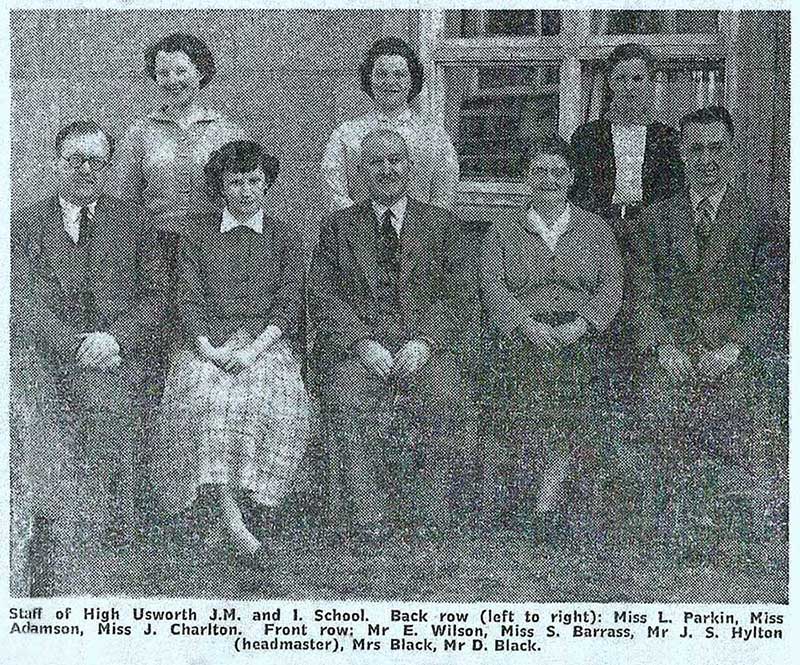
Headmaster, Mr James S. Hylton and his Teaching Staff
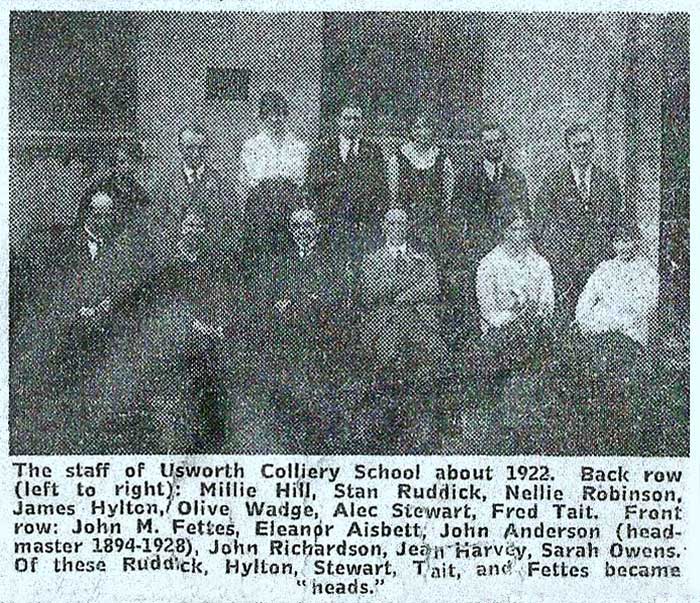
Usworth Colliery Board School - Waterloo Road
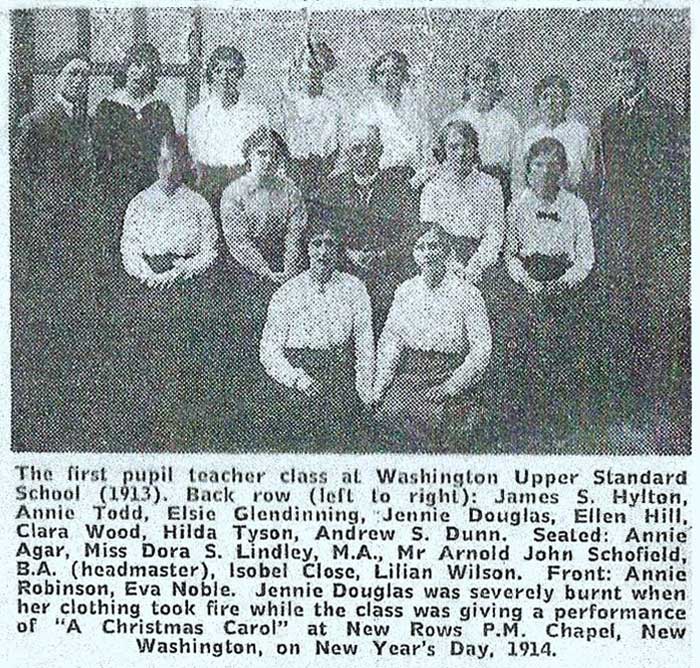
James Hylton
A Pupil Teacher at Washington Upper Standard School, Spout Lane
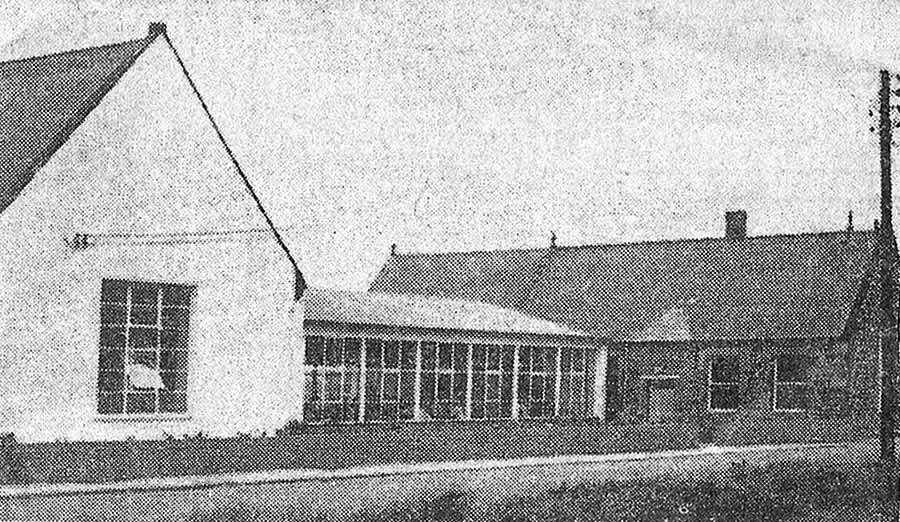
Pawson's Dress Factory and Usworth Board School - Waterloo Road.
Additional Images Associated With The Text
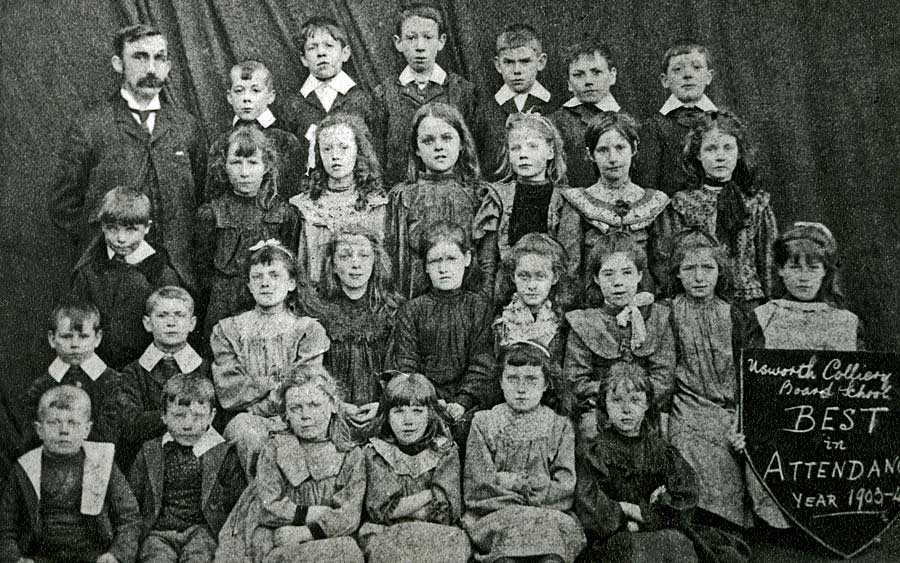
Prize Day at Usworth Colliery Board School, 1904
The boys are wearing 'Eton Collars'.
[ Note George Gibson, centre of back row. To see a pictorial history of George's short but eventful life, Click Me. ]
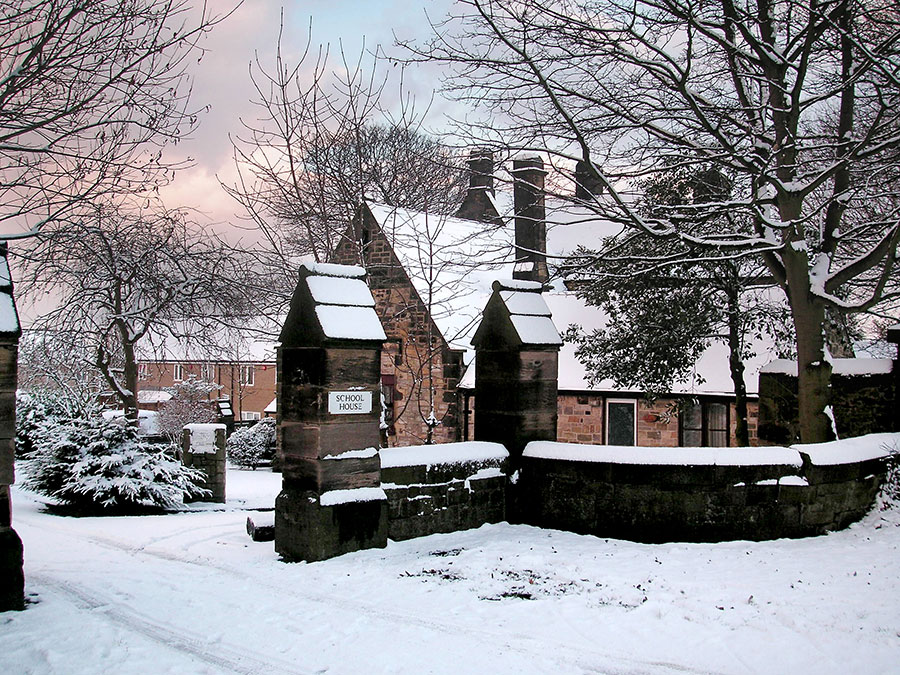
The Entrance and Headmaster's House at the former Great and Little Usworth Board School
That's today's Coach Road Estate in the background.
[ Photographer: Tom Copeman, 1st Jan 2005 ]
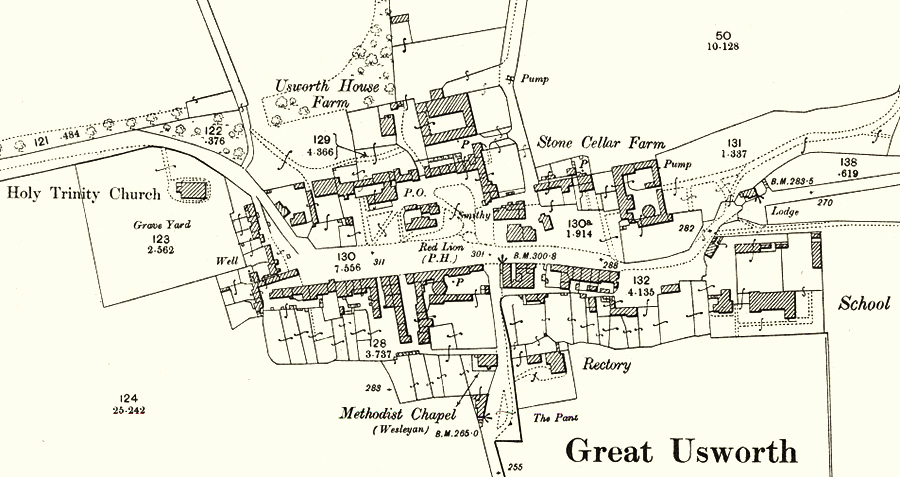
High Usworth School
[ Far Right ]
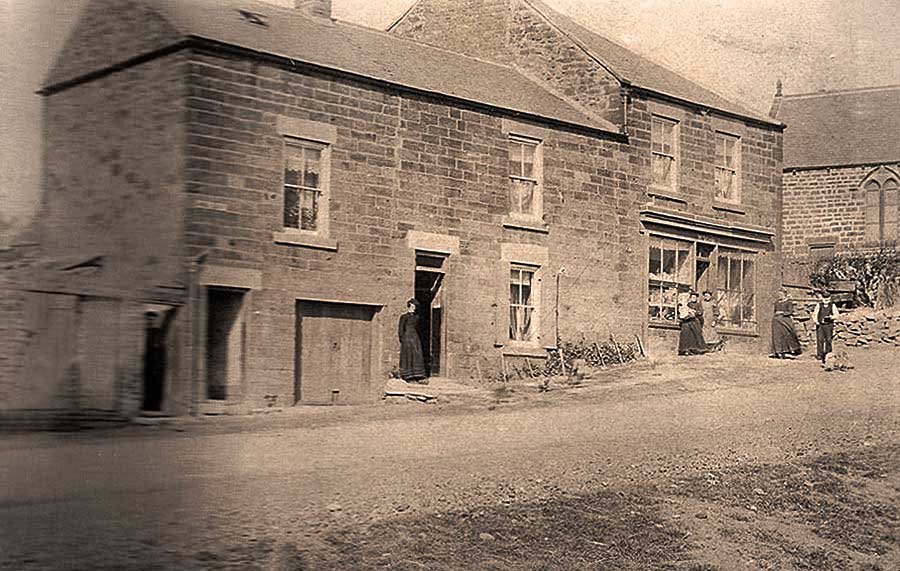
Granny Witts' Shop and the Methodist Chapel on Well Bank. The Well (Pant) was opposite Witts' Shop.
Rev. Begg's Holy Trinity Rectory was opposite the Methodist Chapel.
[ See Map above. ]

Granny Witts' Shop on Well Bank
Note the Twisted Roof!
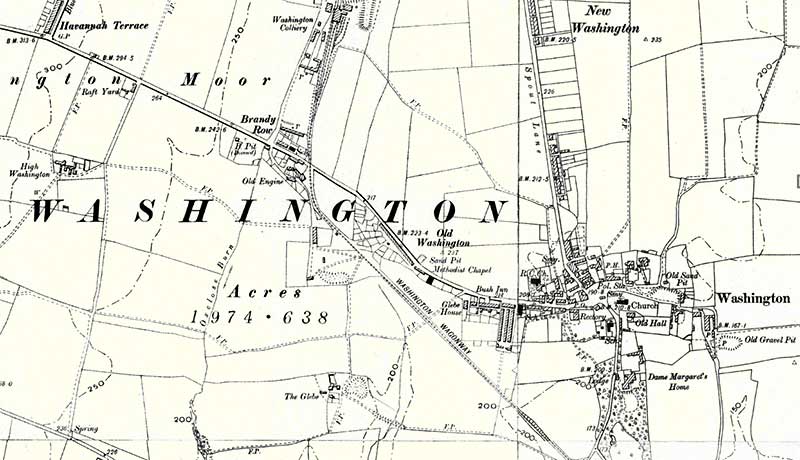
Village Lane Sand-Hole and the 'Old Rows' opposite
[ Below 'TO' in Washington ]